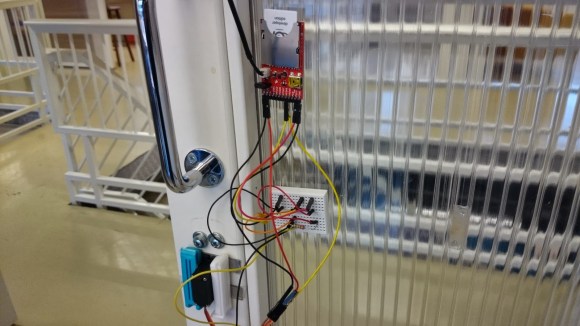
When the folks over at PinMeTo moved into a new office, they were dismayed to find out an extra key would run them a whopping 500 sek (~$75 USD). Instead, they decided to build their own automatic door lock using the Electric Imp system.
If you’re not familiar, the Electric Imp is a small SD card designed to provide internet (Wi-Fi) functionality to consumer devices. While it looks like an SD card, you cannot just plug it into any SD card slot and expect it to work — it still needs a prototyping board. We’ve seen it used to make a wireless thermal printer, or even make a tweeting cat door to let you know of any feline intruders!
Anyway — back to the hack. To move the lock cylinder they’re using a basic RC servo connected directly to the Imp. A flex sensor is installed on the side of the door over-top the lock — this provides feedback to the Imp whether or not the door is in fact locked. The Imp then communicates to Everymote to allow for keypad access from your mobile phone.
It probably ended up costing more in time and money than a new key, but hey, it looks like it was a fun project to do!














What happens when one of those jumper wires pop out when the door closes too hard?
The key is still working as normal so we are always able to get in.
I agree, mine along the lines of, what happens when somebody goes for the handle and gets a hand full of wires instead?
I suspect this isn’t the final version…
Haven’t happened during the five month it have been up. Bigger problem is that the R-pi is losing the internet connection.
Is the RC servo strong enough (i.e. metal parts) to resist someone trying to force the door open?
The RC servo hooks in where a regular cylinder lock should be. So the servo only turn the latch the same way as a key does. It is no tension on the servo when the door is locked or open.
Nice hack, and even if it cost more money than a physical key, didn’t they just create a system with (near) infinite keys?
And suggestion someone spent too much time on a project seems like the sort of thing that should never be mentioned on Hackaday. Or maybe mentioned in every single post. Either way probably works.
As for the loose wires, one would assume (well, I did) they got things working, took some photos, and made a blog post. Good for them! There’s probably a good chance they’ve already started thinking about how to secure things a bit better so there aren’t random wires strewn about.
Of course they could also have replaced the cylinder with a more economical version..
But then it would not have be interesting to us at HaD.
My critique is also the rather ugly and messy way it looks, and I really think it should be cleaned up a bit. There’s no reason to not and plenty to do it.
Electric Gimp! I would never use closed source product.
Interesting, I’m curious what you use to post on hackaday.
Clearly a length of copper connected to the telephone network, a piece of copper that was extracted from the ground and refined with open source tools.
Would have been more impressive/instructional to make their own metal key(s) rather than throw computers at the problem. At least it didn’t use a pile of arduinos I guess.
One thing i don’t get, you go to the lenghts of machining the door frame, but use tape and ikea crap to make an ugly mess, ok it works but it’s ugly. If it’s just a prototype and nonpermanent why mill the door?
I don’t believe they physically altered the door at all. The “inside the lock” picture on their site is what it looks like without half of the deadbolt lock in place. It appears that everything they made can be removed with no damage to the door, thus allowing them to take it with when they leave.
How do these ethernet module’s work? I mean, if I have an RS-232 microcontroller that I want to control and view status over ethernet, how much web/socket programming is needed?
I see many “cloud” platforms
(electricimp, spark.io, xively,nimbits, iobridge, thingspeak,pinoccio, opensense, smartthings, etc)
and many wifi and wired modules
(Redpine, Wiznet, TI (CC3000, RDK-S2E), lantronix xport, Digi Connect, Roving Networks/Microchip WiFly (ZG2100MC, enc28j60, RN171/ RN131), etc)
that it’s hard to tell what all the differences are, or if all these address different problems. In general, what parts of the TCP/IP stack do they handle encapsulate? Obviously the PHY/MAC-LINK layers, but TCP? UDP? What’s the application process look like for updating a webpage for example.
I’m a little weary of being locked into a particular platform cloud solution, but also don’t know how much headache they’re saving me from starting with a bare-metal CC3000!